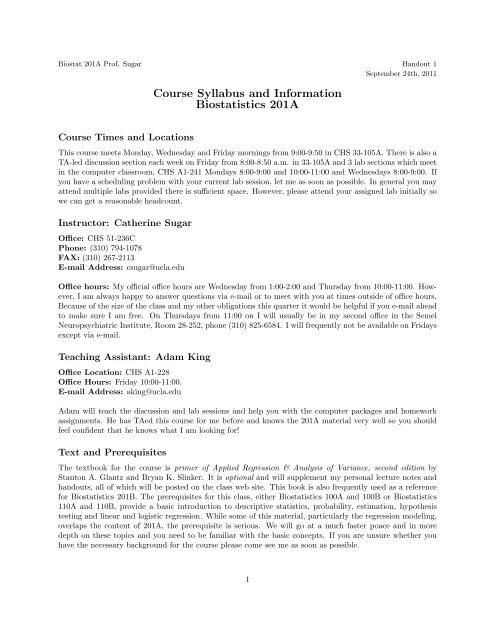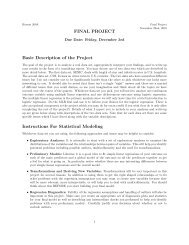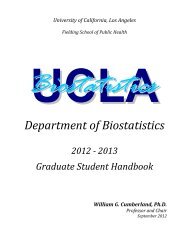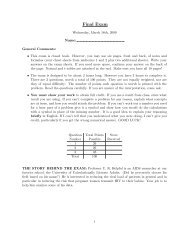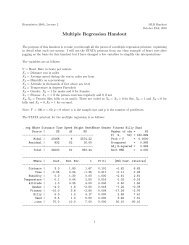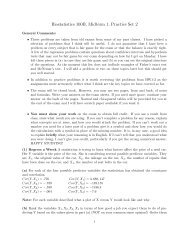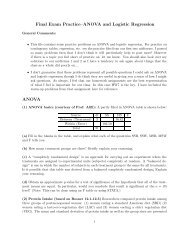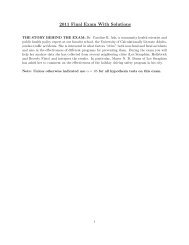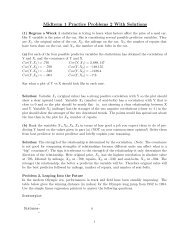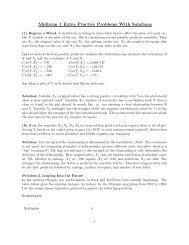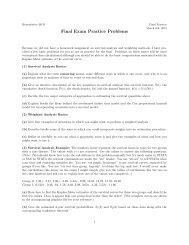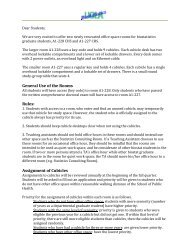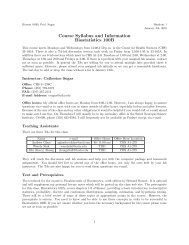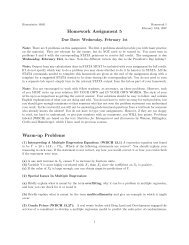Course Syllabus and Information Biostatistics 201A - UCLA ...
Course Syllabus and Information Biostatistics 201A - UCLA ...
Course Syllabus and Information Biostatistics 201A - UCLA ...
- No tags were found...
Create successful ePaper yourself
Turn your PDF publications into a flip-book with our unique Google optimized e-Paper software.
Biostat <strong>201A</strong> Prof. Sugar H<strong>and</strong>out 1September 24th, 2011<strong>Course</strong> <strong>Syllabus</strong> <strong>and</strong> <strong>Information</strong><strong>Biostatistics</strong> <strong>201A</strong><strong>Course</strong> Times <strong>and</strong> LocationsThis course meets Monday, Wednesday <strong>and</strong> Friday mornings from 9:00-9:50 in CHS 33-105A. There is also aTA-led discussion section each week on Friday from 8:00-8:50 a.m. in 33-105A <strong>and</strong> 3 lab sections which meetin the computer classroom, CHS A1-241 Mondays 8:00-9:00 <strong>and</strong> 10:00-11:00 <strong>and</strong> Wednesdays 8:00-9:00. Ifyou have a scheduling problem with your current lab session, let me as soon as possible. In general you mayattend multiple labs provided there is sufficient space. However, please attend your assigned lab initially sowe can get a reasonable headcount.Instructor: Catherine SugarOffice: CHS 51-236CPhone: (310) 794-1078FAX: (310) 267-2113E-mail Address: csugar@ucla.eduOffice hours: My official office hours are Wednesday from 1:00-2:00 <strong>and</strong> Thursday from 10:00-11:00. However,I am always happy to answer questions via e-mail or to meet with you at times outside of office hours.Because of the size of the class <strong>and</strong> my other obligations this quarter it would be helpful if you e-mail aheadto make sure I am free. On Thursdays from 11:00 on I will usually be in my second office in the SemelNeuropsychiatric Institute, Room 28-252, phone (310) 825-6584. I will frequently not be available on Fridaysexcept via e-mail.Teaching Assistant: Adam KingOffice Location: CHS A1-228Office Hours: Friday 10:00-11:00.E-mail Address: aking@ucla.eduAdam will teach the discussion <strong>and</strong> lab sessions <strong>and</strong> help you with the computer packages <strong>and</strong> homeworkassignments. He has TAed this course for me before <strong>and</strong> knows the <strong>201A</strong> material very well so you shouldfeel confident that he knows what I am looking for!Text <strong>and</strong> PrerequisitesThe textbook for the course is primer of Applied Regression & Analysis of Variance, second edition byStanton A. Glantz <strong>and</strong> Bryan K. Slinker. It is optional <strong>and</strong> will supplement my personal lecture notes <strong>and</strong>h<strong>and</strong>outs, all of which will be posted on the class web site. This book is also frequently used as a referencefor <strong>Biostatistics</strong> 201B. The prerequisites for this class, either <strong>Biostatistics</strong> 100A <strong>and</strong> 100B or <strong>Biostatistics</strong>110A <strong>and</strong> 110B, provide a basic introduction to descriptive statistics, probability, estimation, hypothesistesting <strong>and</strong> linear <strong>and</strong> logistic regression. While some of this material, particularly the regression modeling,overlaps the content of <strong>201A</strong>, the prerequisite is serious. We will go at a much faster poace <strong>and</strong> in moredepth on these topics <strong>and</strong> you need to be familiar with the basic concepts. If you are unsure whether youhave the necessary background for the course please come see me as soon as possible.1
<strong>Course</strong> ObjectivesRegression analysis, the study of the dependence of one variable upon other variables, is a central part ofmany research projects. Linear regression is one of the most commonly used forms of statistical modeling,<strong>and</strong> virtually all other regression methods (e.g., logistic regression, Poisson regression, multilevel modeling,Cox regression in survival analysis) are extensions of linear regression. The main objective of this course is tolearn when <strong>and</strong> how to use linear regression <strong>and</strong> related methods <strong>and</strong> how to properly interpret the results.This course is designed for masters <strong>and</strong> doctoral students in fields outside of biostatistics <strong>and</strong> will have aheavy emphasis on practical applications as opposed to theoretical development. A detailed outline of thelecture topics is provided in the course sechedule h<strong>and</strong>out <strong>and</strong> the associated ASPH (associated Schools ofPublic Health) learning objectives <strong>and</strong> conmpetencies are listed at the end of this syllabus.ComputingBecause the focus of this class is data analysis <strong>and</strong> statistical modeling, we will make considerible use ofstatistical computing programs. Through the labs <strong>and</strong> discussions we will introduce you to both STATA <strong>and</strong>SAS, two widely used packages. In some instances we will ask you to use a particular package to get youaccustomed to its format <strong>and</strong> in other cases we will let you use the package of your choice. The necessaryinstructions in both packages will be provided as part of the homework assignments. STATA <strong>and</strong> SAS areboth available on the computers in Technology <strong>and</strong> Learning Center (TLC) lab in the Biomed Library <strong>and</strong>the CLiCC lab, or you can purchase a copy for use on your own computer. For additional campus locations<strong>and</strong> other statistical resources see the links on the class web page. The is also a useful set of tutorials on the<strong>UCLA</strong> Academic Technology Services website, http://www.ats.ucla.edu/stat/.H<strong>and</strong>outs <strong>and</strong> the Class Web SiteOur class web site is http://www.biostat.ucla.edu/course/201a/fall2011. I will post all course materialsincluding the assignments, solutions, lecture notes, practice exams, class notices, etc. on this site, somake sure you check it regularly.HomeworkI consider homework to be the single most important component of this class. It is extremely hard to learnstatistics, or enjoy it, without working through a large number of examples. Assignments will be made <strong>and</strong>turned in on a roughly weekly basis. They will consist of a combination of mathematical problems <strong>and</strong> minidata analysis projects. The write-up is as important as getting the “right” answer. Your homeworkshould always include English explanations of what you are doing, why you are doing it, <strong>and</strong> what theanalysis allows you to conclude. If you do not do so, you WILL lose points! An attempt will be made tochoose problems <strong>and</strong> examples from various areas of public health, medicine <strong>and</strong> current events to make theclass more interesting <strong>and</strong> relevant.Generally, I will give out homework assignments on Mondays <strong>and</strong> they will be due in class the followingMonday though I reserve the right to adjust the timing. In case people have a few last questions afterworking on the homework over the weekend, I will allow assignments to be turned in to the TA’s folderin the <strong>Biostatistics</strong> Department Office, CHS 51-254, up until 3:00 pm on the due date. Other than thisgrace period, no late homework will be accepted except in extraordinary circumstances <strong>and</strong> with my priorapproval. You may drop your lowest homework score. Solutions to warm-up problems will be posted onthe web when the assignment is h<strong>and</strong>ed out <strong>and</strong> solutions to the turn-in problems will be added after theassignments are h<strong>and</strong>ed in. Graded assignments will be returned in class <strong>and</strong>/or your lab session as soonas possible after the due date–in most cases in about a week. Concerns about grading should be reporteddirectly to me. Changes in scores will not be made more than two weeks after an assignment or exam has2
een returned. Unclaimed assignments will be kept in a box in my office up until grades have been submittedat the end of the quarter <strong>and</strong> then discarded.Final ProjectIn addition to the homework assignments there will be a final project consisting of an in depth analysis ofa real data set. The project will be due in the final week of class. Detailed instructions will be h<strong>and</strong>ed outlater in the quarter when we have acquired enough modeling techniques to productively begin to work on it.Academic IntegrityAcademic integrity is an important part of university life, <strong>and</strong> will be taken seriously in this class. You maywork on the homework assignments with other students. In fact, interaction with your classmates is stronglyencouraged. However, each student must write up each assignment on their own <strong>and</strong> in theirown words. There is to be no collaboration during examinations.Students with DisabilitiesAny student requesting academic accommodations based on a disability should register with the <strong>UCLA</strong>Office for Students with Disabilities. A letter of verification for approved accommodations can be obtainedfrom the OSD. Please be sure the letter is delivered to me as early in the quarter as possible so that Ican make any necessary arrangements. The OSD is located in A255 Murphy Hall <strong>and</strong> their website ishttp://www.osd.ucla.edu.ExamsThere will be a midterm <strong>and</strong> a final exam in this course:Midterm 1: Friday, October 28th, During Discussion/Lecture: 8:00-9:50 a.m. (110 minutes)Final Exam: Tuesday, December 6th, 3:00-6:00 pm.(180 minutes), location TBAThe exams are closed book, closed notes. However, you may bring 2 sheets of paper (8.5 by 11) with formulas<strong>and</strong> notes on both sides to the midterm, <strong>and</strong> your midterm notes plus two additional sheets to the final. Youshould also bring a calculator <strong>and</strong> writing instrument. Any additional materials, including numerical tables,will be provided unless specified in class prior to the exam. In general I do not give late, early, or repeatexams except where required by university policy. However I know that this year’s midterm falls right beforethe APHA meeting. Please let me know ASAP if this creates a travel problem for you.GradesGrades will be based on:20% Homework <strong>and</strong> mini data analysis projects. (There will be 7-8 graded assignments, weighted equallyunless specifically noted otherwise, <strong>and</strong> you may drop your lowest score.)25% Midterm20% Final Project35% Final ExamIf it is to your benefit, you may drop the lower of the your midterm score to 10% <strong>and</strong> increase the weight ofthe final exam to 50%. You will automatically be given the optimal score. There are no decisions to makein advance. It is also worthwhile to participate in class. Although it is not part of the numerical gradingformula, I do take effort <strong>and</strong> participation into account when determining the grade cutoffs.3
Learning Objectives <strong>and</strong> Competencies4


